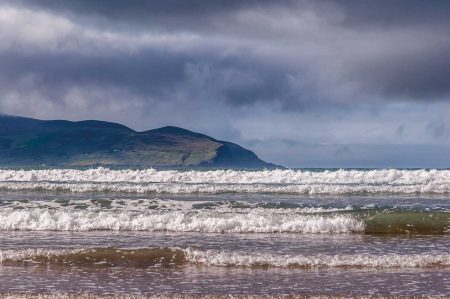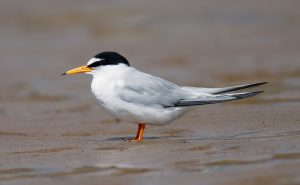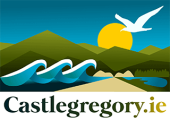
 Castlegregory is right at the centre of one of the best birdwatching areas in Kerry. The north side of the Dingle Peninsula is famous for seabirds and wildfowl in particular, along with a strong supporting cast of waders, gulls, terns and many others. Kilshannig and Rough Point, The peninsula north of Castlegregory is good for waders in autumn and winter, and occasionally attracts large numbers of gulls. Several hundred Ringed Plovers and Sanderling can often be seen on the sandy beaches and the rocky, seaweed covered shore is one of the best places in Kerry to see Purple Sandpipers.
Castlegregory is right at the centre of one of the best birdwatching areas in Kerry. The north side of the Dingle Peninsula is famous for seabirds and wildfowl in particular, along with a strong supporting cast of waders, gulls, terns and many others. Kilshannig and Rough Point, The peninsula north of Castlegregory is good for waders in autumn and winter, and occasionally attracts large numbers of gulls. Several hundred Ringed Plovers and Sanderling can often be seen on the sandy beaches and the rocky, seaweed covered shore is one of the best places in Kerry to see Purple Sandpipers.
Lough Gill is a large shallow freshwater, reed-fringed lake just to the west of Castlegregory, and by far the most obvious birds here are the large numbers of Mute Swans, but mixed in with these between October and late April, are Whooper Swans, winter visitors from Iceland and Greenland. Winter is generally the best time for bird-watching in this area, with Tufted duck, and Scaup all present in good numbers. In summer, Reed Bunting and Sedge Warbler are common. View the lake from the east side, signposted from the outskirts of Castlegregory.


The reed bed hosts more secretive species such as Snipe and Water Rail. Nearby Brandon Bay has a very different mix of wildfowl. A large coastal bay, particularly good in winter for divers, seabirds and scoter flocks, with over 700 Common Scoter usually present. Auks, waders and gulls are often present in large numbers, and Gannets are often seen fishing offshore. No swans here, but several hundred, sometimes a thousand or more, Common Scoter. These all-black sea duck can be seen bobbing offshore beyond the surf line and are occasionally joined by the rare Velvet Scoter, and a transatlantic visitor, the Surf Scoter, is recorded here most winters. Further out in the bay, there can be huge gatherings, or “rafts”, of more oceanic species, such as Manx Shearwater, Gannet, Fulmar, Razorbill and Guillemots.
With suitable winds, one of the finest sea watching locations in Europe The Contrast in ecosystems between the marshy Cloghane Estuary and the rugged cliffs in Brandon Point lead to variety of birds choosing to habitat here, Brandon point protrudes far out into the sea, and in certain conditions, particularly in autumn, when a strong west or north-west wind blows, thousands of seabirds can be seen passing the headland.  On occasion, 10,000 or more Gannets and Kittiwakes might pass, with 25,000 Manx Shearwaters, several hundred Fulmars, Sooty Shearwaters and auks, and the possibility of some truly rare seabirds – A Fea’s Petrel from Madeira, a Little Shearwater from the Canaries, or a Long-tailed Skua from the high Arctic – all have been recorded from Brandon Point during autumn gales..
On occasion, 10,000 or more Gannets and Kittiwakes might pass, with 25,000 Manx Shearwaters, several hundred Fulmars, Sooty Shearwaters and auks, and the possibility of some truly rare seabirds – A Fea’s Petrel from Madeira, a Little Shearwater from the Canaries, or a Long-tailed Skua from the high Arctic – all have been recorded from Brandon Point during autumn gales..
Head on over to https://www.dingle-peninsula.ie/images/birds/birding.PDF for a article from Bird Watch Ireland.
The peninsula and beaches to the north of Castlegregory and the estuary at Cloghane are all good areas for a wide variety of waders, with perhaps the commonest being Sanderling, small whitish birds that run along the waters edge on the more open beaches like small clockwork toys. Redshank, Greenshank and Turnstones are all common, as is Curlew, Ringed Plover and Bar-tailed Godwit, and the stone and rock beaches around Scraggane and Rough Point


are well known as the winter haunt of Purple Sandpipers, the only regular wintering site for this species in Kerry.
Summer sees a change of species, and birdwatcher’s attention switches to the large breeding colonies of birds on the Maharees islands. This area is the summer home of no less than 13 seabird species, nine of which are in numbers categorized as of National Importance. These are Storm Petrel (about 1200 nests), Shag, Common Gull, Lesser Black-backed Gull and Herring Gull. The remaining three are species of tern for which the islands are well known. Common Terns, Arctic Terns and Little Terns all breed on several of the islands. The Little Tern colony is one of only five colonies remaining in Ireland, and about 15 to 20 pairs nest in most summers. A further two speices of tern, Roseate Tern and Sandwich tern, have nested in the past, and could do so again, so the seabird diversity of these islands is one of the highest in Ireland.
Whatever the time of year, there is plenty to see around Castlegregory. Bring a pair of binoculars, and have a good look yourself. Check out http://www.kerrygems.com/kerry-gems-app/birdwatching-locations/


